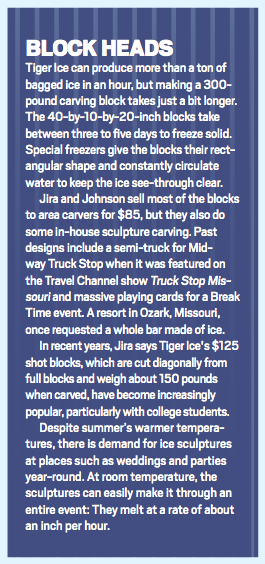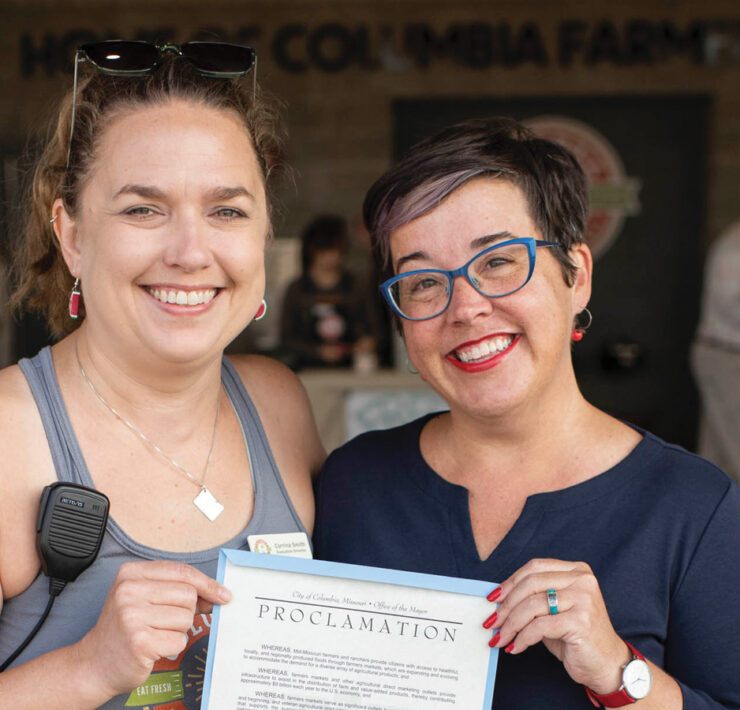Ice Ice Baby
 In the ice industry, weather is everything.
In the ice industry, weather is everything.
Tiger Ice General Manager Andy Jira’s favorite holidays are hot and sunny ones.
“When it rains on the Fourth of July, it can cut our sales in half, sometimes more,” Jira says.
Fourth of July is peak season for Tiger Ice, which supplies ice to vendors as far as 60 miles from Columbia. When it falls on a Friday, as it does this year, area ice producers move even more product as people plan barbecues and outdoor events all weekend long. Tiger Ice produces 60 tons of ice every 24 hours. Consumers can purchase seven- or 20-pound bags at local retailers such as Schnucks, Break Time and Moser’s Food. Tiger Ice also supplies some annual festivals and University of Missouri football games
Sales are strong for the rest of summer as well. Tiger Ice’s busy season starts around Memorial Day and lasts through Labor Day. In those months, the company sends two trucks, each holding eight tons of ice, out on delivery routes Monday through Friday. The business also stays open for on-call weekend deliveries. On most days, the trucks may come back and deliver another load or two.
In the peak season, Tiger Ice adds five seasonal baggers to its full-time staff of seven. The baggers load sealed bags of ice onto tightly packed pallets. By the time the ice ends up on a pallet and in Tiger Ice’s large freezer, its water has snaked through a series of industrial water filters, freezers and bagging machines.
Crystal clear
The reason bagged ice tastes better than what comes out of the average freezer ice machine lies in commercial ice production’s water filtration system. At Tiger Ice, machines pump water out of a state-approved well that lies below the production facility. From there, it’s chlorinated to remove germs, filtered three times to remove minerals, de-chlorinated to improve taste and run through two UV lights to provide further sanitation.
“You’re getting really pure water; there’s no question about it,” says Vice President of Marketing Amy Johnson.
Jira says he sometimes wishes he could take the ice’s water home with him.
“It tastes delightful,” Jira says. “I wish I had that water in my house.”
After passing through the filtration system, the water enters a freezing cylinder, a hulking gray contraption filled with tubes. Freon, a coolant, lines the outside of the tubes. As water passes through the series of tubes, it freezes from the outside in. The constant water circulation keeps the ice clear; the tube series gives the ice its circular shape. The end of the machine has knives that chunk off the long tubes into drink-sized pieces.
In ice-production lingo, the stuff that comes from frozen water is called wet ice. Its counterpart, dry ice, is solid carbon dioxide. Tiger Ice sells some dry ice, too, mostly to area laboratories, but the heart of its business is in its in-house wet ice production.
Technically, wet ice could be wetter. After freezing, it spends time in a silver hopper, where excess moisture drips off. After the wet ice is dry enough, it moves to the ice bin, a 26- to 28-degree room where ice awaits bagging. Automated rakes in the bin rake the ice closer to the bagging machine, which uses air compression and sensors to fill each bag with exactly seven or 20 pounds of ice.
The machine then heat-seals each bag and sends it on a conveyer belt and into a bagger’s hands. Baggers work without gloves or coats, as the main bagging area is kept at room temperature. They load each pallet with two tons of ice. The pallets are more than 6 feet high when fully stacked, but Tiger Ice’s massive 0-degree freezer can hold 200 of them. The freezer space also allows Tiger Ice to do some cold storage for local beef producers Show-Me Farms and Missouri Legacy Beef.
Local industry
Despite sending out 32,000 pounds of ice on most summer days, Jira says his business is still on the small side as ice producers go. Tiger Ice serves a 45- to 60-mile radius, depending on the direction. Its big accounts are the convenience and grocery stores, MU, and annual events such as the Salute to Veterans Airshow and the Roots N Blues N BBQ Festival. Most restaurants have in-house ice machines, but there’s also solid business in trucking ice to restaurants with broken machines.
Tiger Ice has expanded over the years. The production facility has been in its current location off of Route 40 for about a decade after upgrading from a smaller plant across the highway. Jira says as he began to produce more ice, more business followed.
“It’s amazing how when you have a better facility, and you can make more ice, you can sell more ice,” Jira says.
Although technically outside of city limits, Tiger Ice is the city’s closest ice supplier. The second nearest is Hilke’s Ice in Freeburg, about an hour away. Mid America Ice in Clinton is about two hours from Columbia. It produces between 85 and 100 tons of ice a day and supplies clients such as the Missouri State Fairgrounds in Sedalia.
Hilke’s Ice, the largest production plant in mid-Missouri, has a sales radius of about 100 miles and supplies Columbia’s Walgreens, Midwest Petroleum stores, some Casey’s General Stores and Bengal’s Bar & Grill. Its three tube icemakers produce about 130 tons of ice a day, and a fleet of 20 vehicles makes multiple daily runs during the peak season. Its largest trucks can hold 22 tons of ice.
Hilke’s employs 30 to 35 people during the summer months. The seasonal workers augment the year-round staff by serving as drivers, ice stackers and office workers. About half of those workers stay on year round.
Like Tiger Ice, sales at Hilke’s don’t dry up after Labor Day hits.
“You have to carry a decent inventory through the winter,” says Laron Hilke, who serves as the company’s general manager.
But Hilke says the ice industry has changed over the years. New Year’s Eve began to fall in the early 2000s when area police began cracking down on DWI offenses. In recent years, a renaissance in Missouri’s wineries has kept Hilke’s busy supplying ice through September and early October.
“The business has changed somewhat,” Hilke says. “September is getting stronger.”
Hilke says sales take a sharp slide — as high as 50 percent — in mid-August when students head back to school. Area wine tours, however, have grown more popular in recent years and continue into the fall. Hilke’s supplies several area wineries.
Family-owned
Now in its 40th year, Hilke’s remains family owned and has three generations of the Hilke family working at the facility. Laron Hilke’s parents, John and Marie Hilke, founded the company and are still involved in its operations. In recent years, Laron Hilke’s stepchildren, Katie and Zachary West, have also joined the company.
Johnson and Jira at Tiger Ice are siblings, and their father, Chuck Jira, still helps out at the company he founded. Jira and Johnson say keeping the family business going just made sense; both of them grew up around the industry and spent time in high school helping out with the company.
Jira attributes the area’s few ice suppliers and the business’s strong family ties to the industry’s specialized nature. The machines are expensive, as are the specialty parts needed for repairs. Johnson and Jira recently purchased a second bagging machine for $120,000.
“It’s a very expensive startup cost,” Johnson says. “And yet you’re selling a bag of frozen water.”





